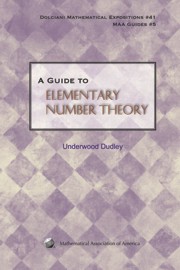Book contents
- Frontmatter
- Introduction
- Contents
- 1 Greatest Common Divisors
- 2 Unique Factorization
- 3 Linear Diophantine Equations
- 4 Congruences
- 5 Linear Congruences
- 6 The Chinese Remainder Theorem
- 7 Fermat's Theorem
- 8 Wilson's Theorem
- 9 The Number of Divisors of an Integer
- 10 The Sum of the Divisors of an Integer
- 11 Amicable Numbers
- 12 Perfect Numbers
- 13 Euler's Theorem and Function
- 14 Primitive Roots and Orders
- 15 Decimals
- 16 Quadratic Congruences
- 17 Gauss's Lemma
- 18 The Quadratic Reciprocity Theorem
- 19 The Jacobi Symbol
- 20 Pythagorean Triangles
- 21 x4 + y4 ≠ z4
- 22 Sums of Two Squares
- 23 Sums of Three Squares
- 24 Sums of Four Squares
- 25 Waring's Problem
- 26 Pell's Equation
- 27 Continued Fractions
- 28 Multigrades
- 29 Carmichael Numbers
- 30 Sophie Germain Primes
- 31 The Group of Multiplicative Functions
- 32 Bounds for π(x)
- 33 The Sum of the Reciprocals of the Primes
- 34 The Riemann Hypothesis
- 35 The Prime Number Theorem
- 36 The abc Conjecture
- 37 Factorization and Testing for Primes
- 38 Algebraic and Transcendental Numbers
- 39 Unsolved Problems
- Index
- About the Author
Introduction
- Frontmatter
- Introduction
- Contents
- 1 Greatest Common Divisors
- 2 Unique Factorization
- 3 Linear Diophantine Equations
- 4 Congruences
- 5 Linear Congruences
- 6 The Chinese Remainder Theorem
- 7 Fermat's Theorem
- 8 Wilson's Theorem
- 9 The Number of Divisors of an Integer
- 10 The Sum of the Divisors of an Integer
- 11 Amicable Numbers
- 12 Perfect Numbers
- 13 Euler's Theorem and Function
- 14 Primitive Roots and Orders
- 15 Decimals
- 16 Quadratic Congruences
- 17 Gauss's Lemma
- 18 The Quadratic Reciprocity Theorem
- 19 The Jacobi Symbol
- 20 Pythagorean Triangles
- 21 x4 + y4 ≠ z4
- 22 Sums of Two Squares
- 23 Sums of Three Squares
- 24 Sums of Four Squares
- 25 Waring's Problem
- 26 Pell's Equation
- 27 Continued Fractions
- 28 Multigrades
- 29 Carmichael Numbers
- 30 Sophie Germain Primes
- 31 The Group of Multiplicative Functions
- 32 Bounds for π(x)
- 33 The Sum of the Reciprocals of the Primes
- 34 The Riemann Hypothesis
- 35 The Prime Number Theorem
- 36 The abc Conjecture
- 37 Factorization and Testing for Primes
- 38 Algebraic and Transcendental Numbers
- 39 Unsolved Problems
- Index
- About the Author
Summary
This Guide is short, so this introduction will be short as well.
It contains most of the topics that are typically part of a first course in elementary number theory as well as some others that could be. It is intended for two kinds of readers. The first are those who once knew but have forgotten, for instance, which integers are the sum of two squares and why they have that property, and who want their memories refreshed. The second are those who were never told about sums of two squares and want to find out about them, quickly and with no nonsense. The Guide is not a textbook—for one thing there are no exercises—but I like to think that someone new to elementary number theory could go through it and come out ahead.
The Guide does not contain some things that I will mention here lest readers think that they were omitted through carelessness. There is no material on cryptography because that is an application of number theory. Elliptical curves are intermediate, not elementary, number theory. Only a few well-known diophantine equations appear. Quadratic forms are missing, in spite of the hundreds of hours that Gauss so profitably devoted to them. Algebraic number theory is a whole other subject. Finally, there are no references to the literature or suggestions for further reading. In these electronic days, the Web has a vast amount of material on any subject in the Guide, growing vaster and vaster every day, that readers can find with a few clicks of the mouse.
- Type
- Chapter
- Information
- A Guide to Elementary Number Theory , pp. vii - viiiPublisher: Mathematical Association of AmericaPrint publication year: 2009



